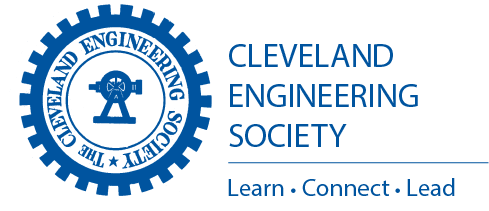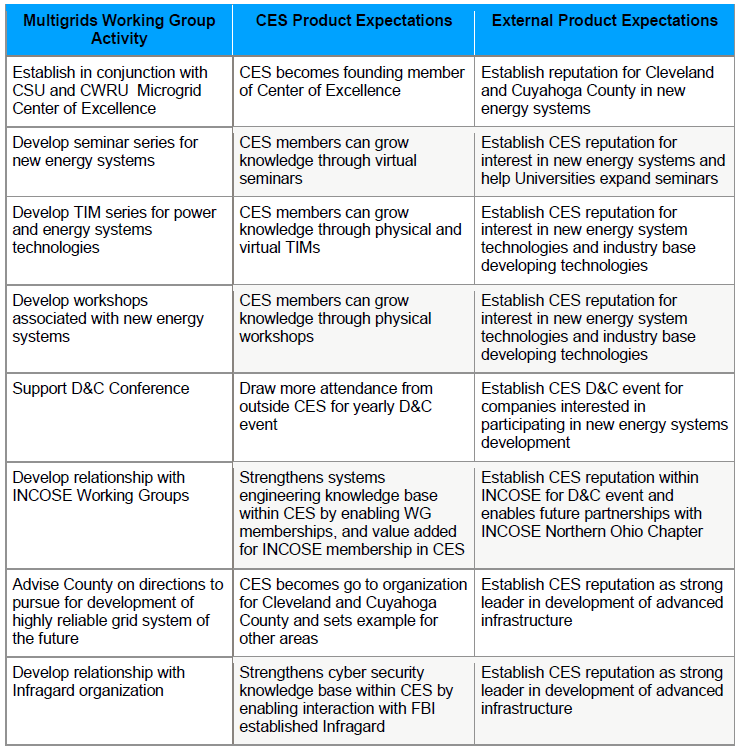
Operating Plan
Cleveland Engineering Society (CES) Multigrids Working Group Operating Plan
1 Purpose
This document describes elements of the Operating Plan for the Multigrids Working Group functioning within the Programs Committee of the CES. It lists and defines the organization, functions, and products for the activity, as well as the Mission and Problem Statements.
2 Scope
The design and construction community is strongly represented in the CES through its membership and corporate support, and exhibited at the yearly sponsored Design and Construction Conference. This working group effort will strive to enable knowledge and understanding of multigrid technologies, and establish engineering design methodologies needed to enable multigrid infusion through CES members.
3 Context
Electric power and energy systems have followed an engineering path that was established in the early 20th century, and is still utilized for terrestrial, aerospace, and marine applications. Despite large growth in capacity these systems still rely on static/small signal criteria and centralized control for stability, separate protection systems, large capacity margins, power peaking without energy storage, and significant regulatory rules. This has resulted in a limited/constrained design space and lack of innovation and experimentation for engineering improvements. Digital technology and digital engineering now provides the opportunity to alter this trajectory by introducing new design and risk management methodologies to enable new 21st century electric energy systems of systems. This design space change will affect academic, industrial, environmental, regulatory, and economic knowledge domains as well.
4 Mission Statement
The greater Cleveland area has a rich history of engineering accomplishments in the automotive, steel, and aerospace industries. These accomplishments were made possible by the engineering design and construction community, represented in the Cleveland Engineering Society, that designed and constructed the industrial and research base. This world class competency is exemplified by the supersonic wind tunnels and engine research building located on the NASA Glenn Research Center (GRC). The development of the multigrid system of systems will require the same level of design engineering excellence, and understanding of technology infusion demonstrated by these previous accomplishments.
This working group activity will utilize CES engineering and business domains to enable understanding of power technologies and design methodologies applicable to the multigrids. Seminars, technical interchange meetings (TIMs), and workshops will be held in cooperation with Universities, NASA GRC, and INCOSE. The Cuyahoga County microgrid effort will serve as a focal point to guide the seminars, TIMs, and workshop planning. The yearly D&C conference will serve as the platform to disseminate progress and information generated from this activity.
5 Problem Statement
The U.S. electric power grid is made up of over 7,300 power plants, nearly 160,000 miles of high-voltage power lines, and millions of miles of low-voltage power lines and distribution transformers, connecting 145 million customers throughout the country. This system of systems has enabled more than a 99% yearly power availability, but is vulnerable to major collapse when power capacity margins are not maintained sufficient to handle large perturbations. Blackouts have increased in number, size, economic loss, and length of time to restore power to all customers. Recent attacks, both physical and cyber, have also heightened awareness of grid security and resiliency issues.
Some of these electric energy system deficiencies have inspired the development of microgrid technologies. Microgrids have limited generating capacity with potentially diverse energy sources, local monitoring/control, energy storage, and utility/island operating modes. The reliance on utility power for redundancy can eventually be replaced by collaborating adjacent microgrids. Larger generating capacity leads to mini and megagrids with similar capability and benefits as microgrids. Collaborating multigrids (micro, mini, mega) can potentially provide the capability to evolve the US power grid with all the benefits of the utility power grid, plus elimination of deficiencies and significant increase in yearly power availability.
The long term goal will be evolvable, collaborative, modular, scalable electrical power systems that enable micro/mini/macro grid systems to transform electric power grids to achieve:
Lower cost
Higher reliability and resiliency
Sustainable growth
Lower emissions and environmental impacts
Innovation concepts, demonstrations and infusion
6 Structure
The focus of the working group activities on multigrids provides a broad context for understanding applicable technologies, supporting methodologies for engineering analysis, and design methodologies needed to enable multigrids (micro, mini, mega) and their system of systems behavior. To accomplish this will require partnering with academia, other professional societies, research agencies, and industry.
This working group will operate under and report back through the CES Programs Committee as indicated in section 1 Purpose. The working group will have a chair and co-chair position both of which must be a CES member, and will seek membership in the group through CES, affiliated organizations, and outside organizations. A byproduct from the inclusion of outside members will be advocacy of CES and membership in CES. Members associated with the working group will be required to identify the community of practice they associate with and technical areas of interest as described in section 8 Process. All groups, subgroups, seminars, meetings, workshops, and products from this effort will be reported through the CES Programs Committee as described in section 9 Communications.
7 Outreach
The Cuyahoga County microgrid initiative provides a unique opportunity for collaboration, near term focus of the working group activity, and initial partnerships with industry and academia. As a part of their effort they identified the need to establish a “center of excellence” in microgrids with both CSU and CWRU. The CES working group should begin by helping in the development of the center of excellence in conjunction with both CWRU and CSU engineering schools. Success in this initial endeavor will demonstrate the value added by the CES with a plan to incorporate the CES into the center of excellence with continuing support through this working group activity.
In addition to the center of excellence effort the working group will pursue further associations to develop seminars, technical interchange meetings (TIMs), and workshops as further described under section 8 Process. Reporting of activities and approval of collaboration agreements will be accomplished through the CES Programs Committee as described in section 9 Communications.
8 Process
As indicated in section 6 Structure the chair and co-chair will be responsible for the organization and operation of the working group. All members will identify with one of the following communities; University, Industry, Government, Research Agency, Society. In addition each member will identify with one or more of the following system technical areas of interest; Energy Source, Energy Conversion, Energy Storage, Power Management and Control, Distribution, Environment. Identification allows for organization of subgroups to aid in the development of future system scenarios, landscape maps, technology road maps (TRL, SRL, S/WRL, MRL), estimated system application time phase.
The outreach effort described in section 7 will be used to support each subgroup by identifying seminars, TIMs, and workshops that can be scheduled to enable collaboration with academia, industry, and government. Initial efforts will focus on the establishment of the microgrid center of excellence to support the county microgrid and invitation to the MIT Changing Electric Energy Systems seminars. Additional efforts will be started with NASA to develop TIMs associated with NASA technology development investments that support future aero and space power systems. Workshops will also be developed in conjunction with the IAPG (Inter Agency Advanced Power Group), Universities, and OAI (Ohio Aerospace Institute) to further expand the knowledge and collaboration for the working group.
The following table captures product expectations from the working group for both the CES and for external partners or associations:
9 Expenditures
Monetary support for the Multigrids working group will come from participation in the working group activities for both CES members and non-members. No separate fees will be required for participation in the working group, and any events will be costed to break even. When fees are required to schedule an event it will be done by pre-registration to enable no expenditures beyond what is available. The following events are expected to require pre-registration to enable venue selection and full understanding of any needs for food or beverage support that will be procured by participants; Technical Interchange Meetings, Workshops, INCOSE Working Group, Infragard Meetings, Tours. As the Multigrids working group expands and becomes more integrated into the CES this expenditure section can be re-evaluated by the CES management to further CES goals and benefits.
10 Communications
As a part of the Programs Committee all activities associated with the working group will be reported and approved through the committee process. Reviews, updates, collaborations, and approvals for the CES board of directors will be done as requested by the Programs Committee. In addition the working group will schedule all activities to enable dissemination at the CES yearly Design and Construction Conference with the specific intent of increasing attendance through this working group effort.
11 Membership
The incorporation of this working group in the CES was done to enhance working group membership from the design and construction industry represented within the CES. As such leaders for this effort will be sought within the CES, with additional support coming form non-CES members to enable the voluntary labor pool to accomplish goals. This effort will be leveraged to aid in advocating the CES and increasing CES membership through association with outside organizations and individuals.

